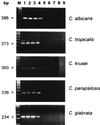Serum is more suitable than whole blood for diagnosis of systemic candidiasis by nested PCR
- PMID: 10074503
- PMCID: PMC88626
- DOI: 10.1128/JCM.37.4.925-930.1999
Serum is more suitable than whole blood for diagnosis of systemic candidiasis by nested PCR
Abstract
PCR assays for the diagnosis of systemic candidiasis can be performed either on serum or on whole blood, but results obtained with the two kinds of samples have never been formally compared. Thus we designed a nested PCR assay in which five specific inner pairs of primers were used to amplify specific targets on the rRNA genes of Candida albicans, C. tropicalis, C. parapsilosis, C. krusei, and C. glabrata. In vitro, the lower limit of detection of each nested PCR assay was 1 fg of purified DNA from the corresponding Candida species. In rabbits with candidemia of 120 minutes' duration following intravenous (i.v.) injection of 10(8) CFU of C. albicans, the sensitivities of the PCR in serum and whole blood were not significantly different (93 versus 86%). In other rabbits, injected with only 10(5) CFU of C. albicans, detection of candidemia by culture was possible for only 1 min, whereas DNA could be detected by PCR in whole blood and in serum for 15 and 150 min, respectively. PCR was more often positive in serum than in whole blood in 40 culture-negative samples (27 versus 7%; P < 0.05%). Lastly, experiments with rabbits injected i.v. with 20 or 200 microgram of purified C. albicans DNA showed that PCRs were positive in serum from 30 to at least 120 min after injection, suggesting that the clearance of free DNA is slow. These results suggest that serum is the sample of choice, which should be used preferentially over whole blood for the diagnosis of systemic candidiasis by PCR.
Figures



References
-
- Bougnoux M E, Dupont C, Mateo J, Saulnier P, Payen D, Nicolas-Chanoine M H. Abstracts of the 37th Interscience Conference on Antimicrobial Agents and Chemotherapy. Washington, D.C: American Society for Microbiology; 1997. Rapid diagnosis of candidemia by DNA amplification applied to serum abstr. D-131; p. 106.
-
- Buchman T G, Rossier M, Merz W G, Charache P. Detection of surgical pathogens by in vitro DNA amplifications. Part 1. Rapid identification of Candida albicans by in vitro amplification of a fungus-specific gene. Surgery. 1990;108:338–347. - PubMed
-
- Burgener-Kairuz P, Zuber J P, Jaunin P, Buchman T G, Billie J, Rossier M. Rapid detection and identification of Candida albicans and Torulopsis (Candida) glabrata in clinical specimens by species-specific nested PCR amplification of a cytochrome P-450 lanosterol-α-demethylase (L1A1) gene fragment. J Clin Microbiol. 1994;32:1902–1907. - PMC - PubMed
Publication types
MeSH terms
Substances
LinkOut - more resources
Full Text Sources
Other Literature Sources
Medical

